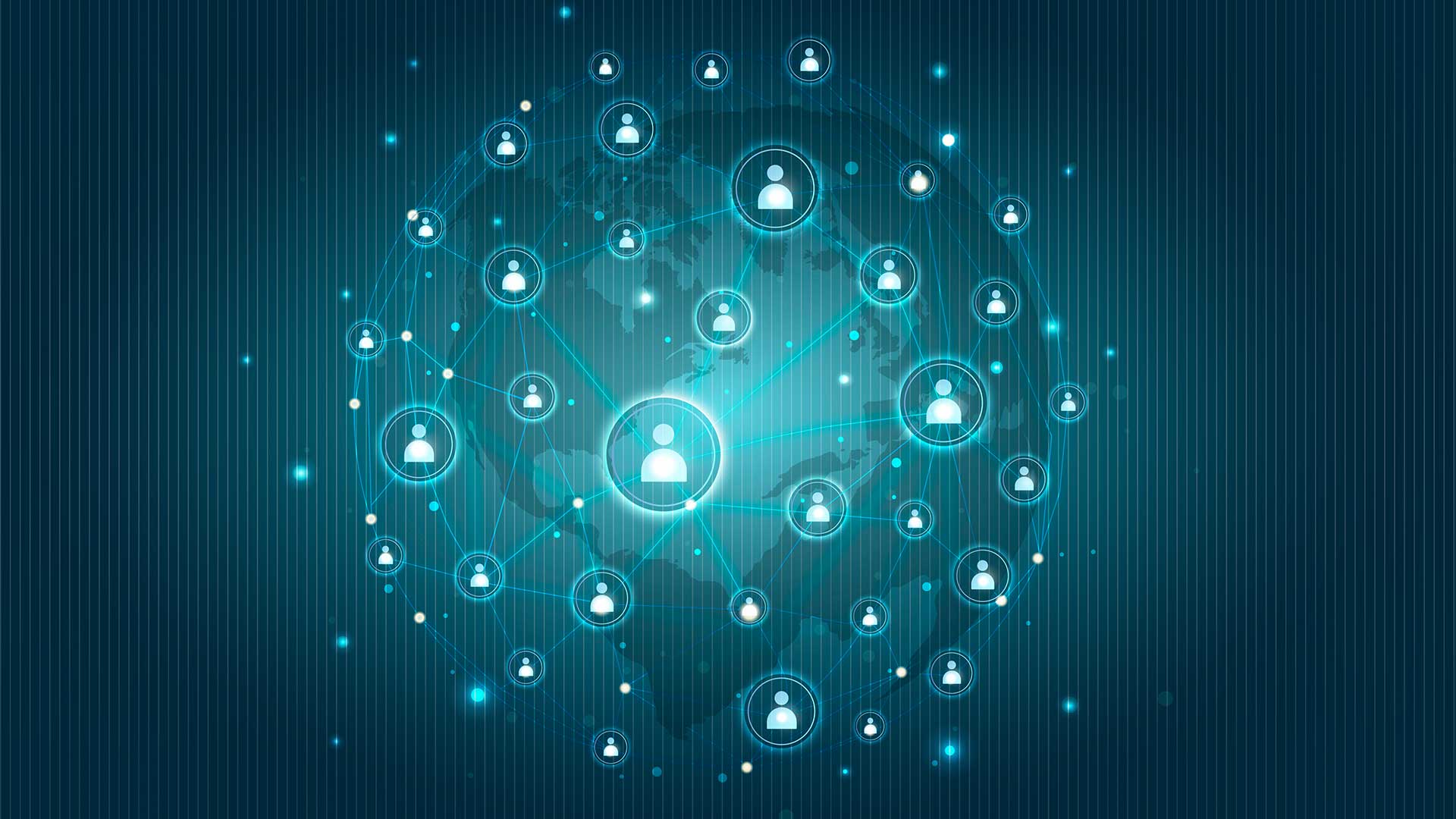What is a decentralized autonomous organization or DAO?
In its simplest terms, a decentralized autonomous organization or DAO is an online blockchain-based organization not governed by a single person or team but by all its users.
From this definition, it’s evident that a DAO is different from a traditional organization in two ways:
- A DAO is an online organization and doesn’t have a physical form.
- A DAO doesn’t have a limited number of stakeholders, but all its users are its stakeholders.
Understanding the concept of DAO is more accessible through examples. Imagine a giant high-tech company like Facebook was governed by decentralized and in the form of a DAO. Do you think this company was able to sell its users’ data to advertising agencies so quickly? Certainly not. Or imagine a bank being governed in the form of a DAO. Can this bank increase the profit it takes from its users without their consent? Definitely not.
Of course, you may have repeatedly heard similar definitions in the crypto world, especially as an answer to the question of what a decentralized autonomous organization or DAO is. This is logical since all Defi projects, including decentralized applications, decentralized lending platforms, and decentralized exchanges, are here for decentralization. However, a decentralized autonomous organization or DAO has some key features that differentiate it from other Defi projects. Stay with us in the next part to discover a straightforward explanation for what a decentralized autonomous organization or DAO really is.
How does a decentralized autonomous organization or DAO work?
A decentralized autonomous organization is, in fact, a smart contract. You know that Ethereum is the world’s first and most popular blockchain supporting smart contracts. For this reason, older DAOs were based on Ethereum. By the way, other smart-contract-supporting blockchains like Solana are becoming as popular today. They are more scalable, faster, and cheaper, and these features have added to their popularity.
Each DAO has one or more than one developer that code it. These codes construct the DAO’s rules and can be tracked publicly. For this reason, a DAO must be coded as carefully as possible. A mistake or a security breach can destroy that DAO, and millions of dollars will be lost.
Exactly like traditional centralized organizations, DAOs can work in different areas. The three main features of a DAO are:
- Using smart contracts
- Having a governance token
- Letting users send proposals
Using smart contracts is obvious. Regarding governance tokens, a governance token is what determines the stakeholders of a DAO. All holders of a DAO’s governance token are considered its stakeholders and can participate in the decision-making process. And finally, DAOs let their users send their opinions on the future of the DAO in the form of proposals. Proposals are then put into a vote, and the holders of the governance token can vote on them. It is applied if the majority agrees with that proposal, and if the majority disagrees, it’s disregarded.
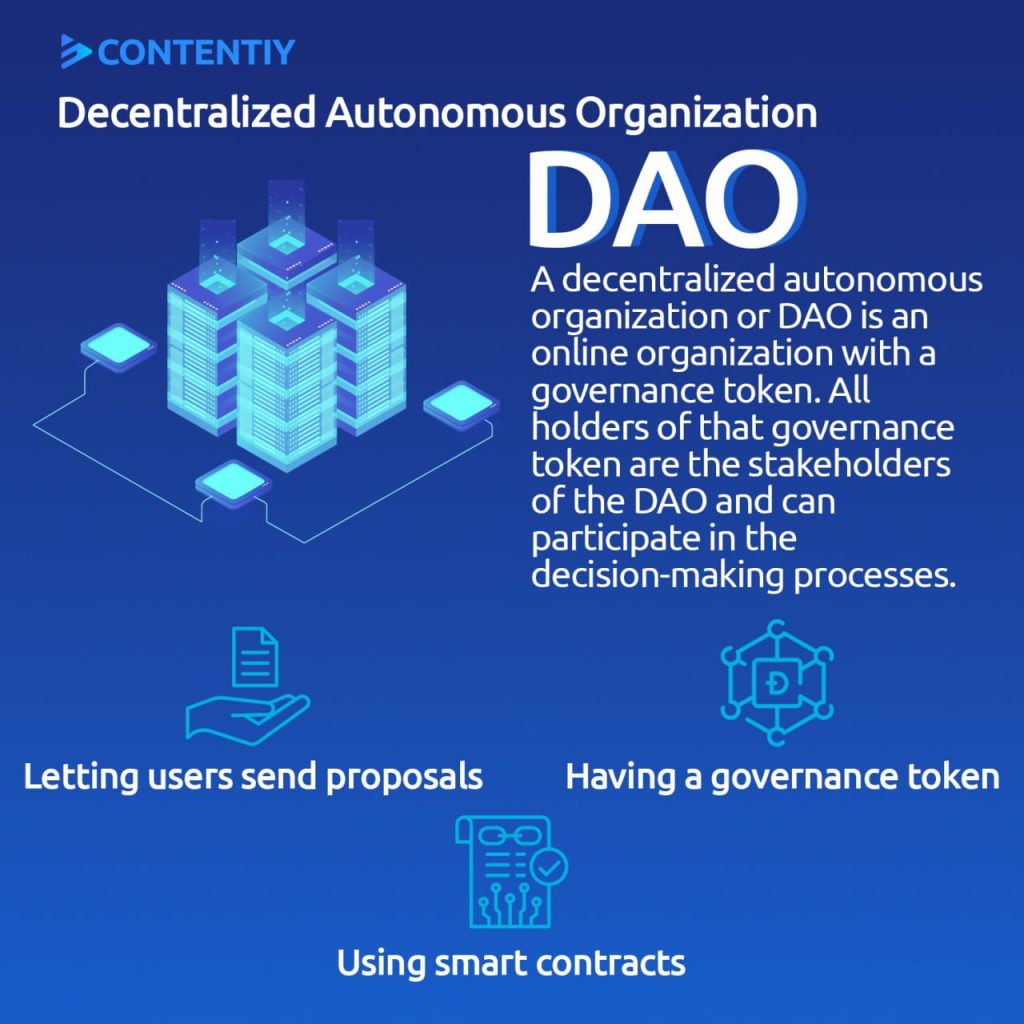
We think the difference between a DAO and other Defi projects is evident. For example, the famous lending platform MakerDAO is a DAO. It has two tokens: DAI and MKR. MKR is the governance token of MakerDAO. With this definition, we find out that Bitcoin is NOT a DAO. Bitcoin doesn’t support smart contracts, and it doesn’t have a governance token.
Famous examples of decentralized autonomous organizations or DAO
In line with the growing popularity of cryptocurrencies, the number of DAOs is also increasing. DAOs aren’t just limited to the examples we refer to below. These are a number of the most famous DAOs we have today.
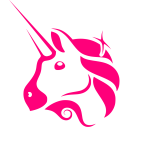
Uniswap
Uniswap is the largest decentralized exchange or DEX that works on the Ethereum blockchain. This platform released its governance token called UNI in September 2020. UNI holders can state their opinions on issues like the number of fees, the rules, and the general roadmap.
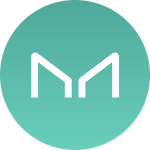
MakerDAO
MakerDAO is a famous decentralized lending platform that works on Ethereum too. As we previously mentioned, MakerDAO has two tokens: Dai and MKR. Dai is a stablecoin, and MKR is the governance token. MKR holders can also participate in decision-making processes like determining the number of fees or the amount of profit.
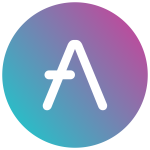
Aave
Aave is another popular decentralized lending platform letting users lend and borrow their cryptocurrencies. Aave’s governance token is AAVE, which has the same functionalities as the previous governance tokens we referred to.
Dash
Dash is a cryptocurrency network and an online payment system that started its work as a fork of Litecoin. Litecoin is a fork of Bitcoin itself, so we can say that Dash is a fork of Bitcoin. The aim of Dash from the beginning was to increase transaction speed and improve scalability. Dash was developed in 2014, so many people know it as the first DAO in the crypto world.
DAOstack
DAOstack is another interesting DAO that many people know as the WordPress of DAOs. DAOstack is an open-source software stack aiming to support a global interactive network of DAOs. This stack can be used for developing DAOs that need interactive group activities. DAOstack’s governance token is called GEN.
Conclusion
In this article, we tried to explain what is a decentralized autonomous organization or DAO and how it works in the simplest possible terms. You have definitely figured out that DAOs use smart contracts like decentralized applications, but be aware that not all decentralized applications are DAOs. A decentralized application must have a governance token and generally offer “decentralized governance” to qualify as a DAO.
The decentralized world is advancing daily and penetrating industries we couldn’t imagine before. It isn’t too far from the imagination that DAOs will completely replace traditional organizations soon. By the way, it’s undeniable that DAOs should also be ready for such a future. They should overcome all possible challenges and increase efficiency to the possible extent.
What is a decentralized autonomous organization (DAO)?
A DAO is a type of organization that is run through a decentralized blockchain network, where decisions are made through a consensus of its members rather than a central authority.
How does a DAO work?
A DAO works through a set of smart contracts on a blockchain network. Members can propose, vote on, and implement changes to the organization through these contracts. Once a proposal is approved, the changes are automatically executed by the network.
What are the benefits of a DAO?
Some benefits of a DAO include increased transparency, fairness, and efficiency in decision-making, as well as the potential for greater accountability and trust in the organization.
What are some examples of DAOs?
Some notable examples of DAOs include MakerDAO, Compound, and Uniswap, which are decentralized finance (DeFi) platforms, as well as MolochDAO and MetaCartel, which are focused on funding and supporting blockchain projects.
How can I participate in a DAO?
To participate in a DAO, you typically need to hold a certain type of cryptocurrency that is used by the organization. You can then join the DAO by submitting a proposal, voting on proposals, or contributing to the organization in other ways.
Are DAOs legal?
The legal status of DAOs is still evolving and varies by jurisdiction. In some cases, DAOs may be subject to existing laws and regulations, while in others they may operate in a legal gray area.
What are some potential risks of participating in a DAO?
Some potential risks of participating in a DAO include the loss of funds due to smart contract bugs or hacks, the possibility of a flawed decision-making process, and the lack of legal protections in the event of disputes or fraud.

